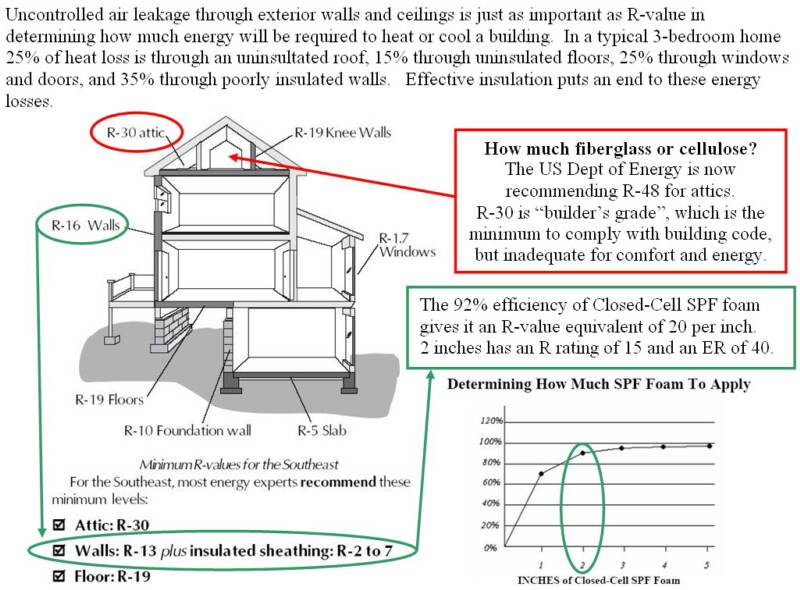The graph on the right at the bottom illustrates the reduction in heat loss from a building when it is insulated with various thicknesses of closed-cell Spray-applied Polyrethane Foam (SPF). This graph points out that, after installing 2 inches of SPF, more foam insulation is not as cost effective. (An extra half inch might be smart, however, on the underside of a roof, where it can provide some additional temperature reduction in an attic where you plan to put a bonus room or in rooms with cathedral / vaulted ceilings where no venting is possible and heat comes right into the room.) The vertical percentages on the left of the graph (Y axis) correspond to the percentage (%) of overall heat loss. Thickness, in inches, is indicated horizontally along the bottom (X axis). The graph shows that from a heat loss perspective, more than 3 or 4 inches of closed-cell foam insulation is pointless, even in Alaska.
SUMMARY: In Georgia, two inches is usually sufficient for closed-cell foam, even on the underside of the roof, although an additional reduction in attic temperature might be achieved by adding another half inch. That extra half inch is recommended for reducing summer temperatures in attics where bonus rooms exist, or if you have an air conditioning system in the attic that you want to protect from as much heat as possible. However, the extra half inch may not be that cost effective—especially when parts of the roof are shaded during a hot summer day. Each attic should be evaluated on its own merits and what you intend for its use. 2 to 2.5 inches under the roof can reduce attic temperatures anywhere between 30 and 100 degrees.
For further information "hot roof" systems see http://www.callvaluetech.com/HotRoof.html
For more informatoin on efficiency ratings, see http://www.callvaluetech.com/USdeptEnergyR.html
For more info on the real meaning of "R-Value" see "R" Fairy Tale: The myth of Insulation values
The "fairy tale" link above has additional informaiton on the graph above. For example, air movement through the material "(infiltration) is stopped with the first one-fourth of an inch of closed-cell urethane foam. The second inch of spray-in-place urethane stops about 90% of heat loss, and the third inch stops about 95% (i.e., an additional 5%) and so forth."

Helping the "Building Green" revolution of energy savings for the planet and the pocket.
See U.S. Government "Green Home" building programs.

Value Tech Insulation Serves Metro Atlanta
and the Southeast U.S.
770-981-9090

Oak Ridge National Laboratory research shows that “perfectly installed” fiberglass batts lose 11% of their labeled
R-Value, and that “commonly installed” fiberglass batts lose 28% of their labeled R-value. The article states: “‘R-19’ batts have an R-value of 13.7 when installed as commonly found in actual walls.” This study confirms tests conducted 20 years ago by fiberglass manufacturers, and reveals the surprisingly large disparity between the labeled R-value and the installed R-value of fiberglass batts. The point is that R-Value is not the best measure of insulation and that fiberglass is the worst kind of insulation.
(Adobe Acrobat PDF reader needed) <<< click here